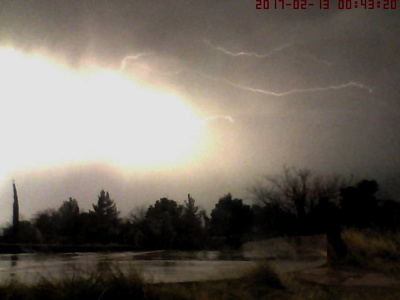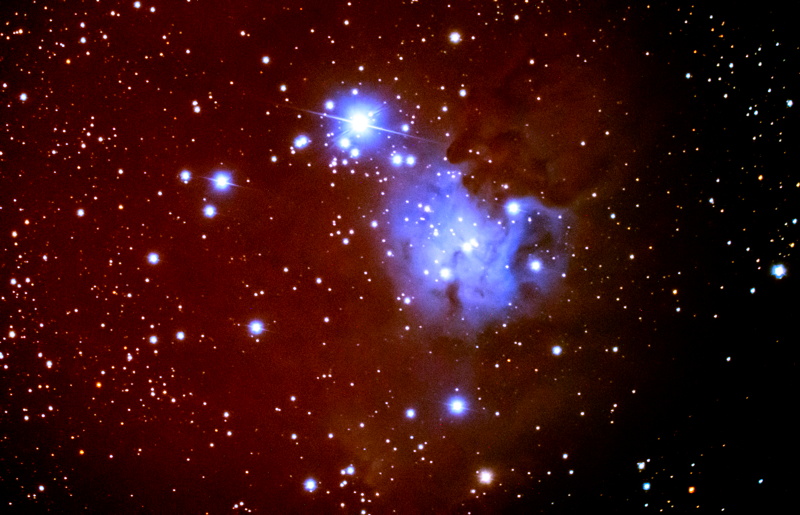Visitors; D7200 DSLR DSO Imaging
Posted: 16 February 2017
Saturday, 11 February 2017, was cloudy in Oracle. That evening I attended the "Adventures with the Moon" at Oracle State Park. The report of that event is on the Oracle Dark Skies Committee web site.
Sunday, 12 February, I did a minor cleanup (vacuum only) inside the observatory. I used to do the annual cleanups on the anniversary of "First Light" in the observatory, which was 18 August 2009. After skipping a couple of years due to high temperatures in August and other reasons, I did a major cleanup last year on 11 February 2016, which was after the 8" telescope was removed but before the new 12" telescope was installed in the observatory. Doing the cleanups in February with its cooler temperatures seemed to make a lot of sense! I hope to continue the annual cleanups on or around 11 February.
Cloudy skies continued. Had some light rain (0.05") with some thunder late Sunday afternoon into Monday morning. My webcams captured some lightning:


Had more light rain (0.04") on Tuesday, 14 February. Clear skies returned on Wednesday, 15 February.
|
Open: Wednesday, 15 February 2017, 1805 MST Temperature: 69°F |
Session: 1073 Conditions: Clear, breezy |
Equipment Used:
12" f/8 LX600 w/StarLock
Wired AutoStar II handset
2" 24mm UWA eyepiece
2" 9mm 100° eyepiece
2" 30mm eyepiece
Camera:
D7200 DSLR
Upon arrival at the observatory I SYNCed the observatory clock to WWV.
1811 MST: 12" LX600 ON, StarLock OFF, High Precision OFF.
Slewed to the star Betelgeuse and SYNCed the AutoStar. 1816 MST: viewed Venus, 102X and 271X. Nice view of the crescent phase planet.
Then prepared the D7200 DSLR for astrophotography later in the night.
Viewed Mars, 271X. Not a good view this night. Seeing was not very good on this fainter small planet.
1900 MST: my visitors from northern Indiana arrived. After introductions and a quick overview of the observatory they viewed Mars and then Venus in the 12" telescope using a magnification of 271X. 1934 MST: viewed Comet Encke, 102X, low in the western sky. The comet was small (no tail) and faint, but they could say they got to view a comet. I pointed out the Zodiacal Light in the western sky; it went from the horizon to almost the zenith. I mentioned that seeing the Zodiacal Light requires a dark location away from light pollution. The Winter Milky Way was also visible running almost horizon to horizon through high overhead. Next was the Andromeda Galaxy (M31). I showed them that it was visible to the naked eye. They then viewed it in the telescope at 81X. They also got to view the Andromeda Galaxy companion galaxies M32 and M110, 81X. They viewed the Double Cluster (open star clusters), 81X. Then the Eskimo Nebula (planetary nebula), 102X. Next they viewed the highlight of the night (besides the dark skies here): the Great Orion Nebula (M42), 102X. Finally, and by request, they viewed Sirius, 102X, the brightest star in the night sky and very bright in the eyepiece. I pointed out that the second brightest star in the night sky, Canopus, was visible just above the southern horizon. 2044 MST: after enjoying the dark night sky here at Cassiopeia Observatory, my guests left. I took a short break.
2059 MST: returned to the observatory and began setting up to image some open star clusters for my Messier Catalog Astrophotography Album update. Slewed to M46 and viewed it, 102X. The planetary nebula NGC2438 was also visible in the eyepiece. Then slewed to the star Procyon, SYNCed the AutoStar, mounted the D7200 DSLR at prime focus + focal reducer, focused using the Bahtinov Mask, and locked the primary mirror. Slewed back to M46. 2115 MST: StarLock ON for autoguiding. Took this 1 minute, ISO 3200, White Balance 4000K image:
M46 (open cluster) and NGC2438 (planetary nebula)

Next, imaged several open star clusters:
M47, 30 seconds, ISO 1600, WB 4000K

M48, 30 seconds, ISO 1600, WB 4000K

M50, 30 seconds, ISO 1600, WB 4000K

M67, 60 seconds, ISO 1600, WB 4000K

M93, 30 seconds, ISO 1600, WB 4000K

Star colors are evident in the above images.
I then began imaging two galaxies, M95 and then M96. 2149 MST: while imaging M95 winds increased and seeing dramatically deteriorated, resulting in poor autoguiding. I was able to only get one good image. This is M95, 1 minute, ISO 6400, WB 4000K:

I will try these galaxies again on a future session.
Slewed the 12" telescope to NGC2264 (Christmas Tree Cluster) and Cone Nebula. Autoguiding was better and I was able to get this 5 minute, ISO 6400, WB 4000K image:

The last Deep Sky Object (DSO) I imaged this night was NGC2237 (Rosette Nebula), 5 minute, ISO 6400, WB 4000K:

2236 MST: ended imaging due to the wind. StarLock OFF.
2250 MST: LX600 OFF. The eastern sky was brightening from the rising waning gibbous Moon.
|
Close: Wednesday, 15 February 2017, 2258 MST Temperature: 48°F |
Session Length: 4h 53m Conditions: Clear, windy |
Comments are welcome using Email. Twitter users can use the button below to tweet this report to your followers. Thanks.
Cassiopeia Observatory Home Page
Copyright ©2017 Michael L. Weasner / mweasner@me.com
URL = http://www.weasner.com/co/Reports/2017/02/16/index.html
